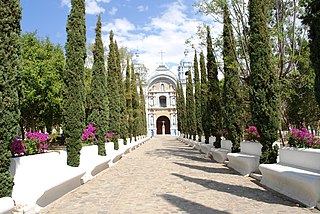
Ocotlán de Morelos is a town and municipality in the state of Oaxaca, about 35 km south of the center of the city of Oaxaca along Highway 175. It is part of the Ocotlán District in the south of the Valles Centrales Region. The area was a significant population center at the time of the Spanish Conquest, and for that reason an important Dominican monastery was established here in the 16th century. The complex still exists, with the church still being used for worship and the cloister area used as a museum. While mostly quiet, the city is an important distribution and transportation center for the south of the Central Valleys region of Oaxaca, a function which is expected to be reinforced with the opening of new highway being built to connect the city of Oaxaca with the Pacific coast. The city is known for artist Rodolfo Morales, who painted aspects of his hometown in his works and sponsored projects to save and restore historic monuments here. For generations the municipality has been known for its crafts, with the ceramics making Aguilar family producing some of the best known craftsmen.
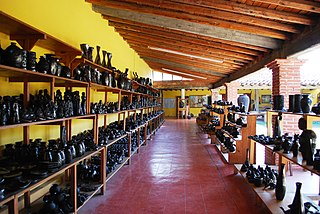
San Bartolo Coyotepec is a town and municipality located in the center of the Mexican state of Oaxaca. It is in the Centro District of the Valles Centrales region about fifteen km south of the capital of Oaxaca.

Santa María Atzompa is a town and municipality located in the Mexican state of Oaxaca, about five km from the state capital of Oaxaca. It is part of the Centro District in the Valles Centrales region. The town was founded between the 7th and 9th centuries as a satellite of the ancient Zapotec city of Monte Albán. Since its founding, pottery making has been a major economic activity and the town is currently known for its green-glazed pottery. This pottery used to be shipped all over Mexico and exported to the United States but today most of this pottery is sold locally. Beginning in 2009, there has been excavation at the Atzompa archeological site, leading to the discovery of a 45-meter Mesoamerican ball court, which has been determined to have been on the principal one for Monte Alban. Today, the town is rustic with the smoke of wood-fired pottery kilns ever present. Poverty has been a concern for the town, but innovations such as the use of lead-free glazing and a communal crafts market have been implemented to improve the craft's prospects.

A Tree of Life is a type of Mexican pottery sculpture traditional in central Mexico, especially in the municipality of State of Mexico. Originally the sculptures depicted the Biblical story of creation, as an aid for teaching it to natives in the early colonial period. The fashioning of the trees in a terracotta sculpture began in Izúcar de Matamoros, Puebla but today the craft is most closely identified with Metepec. Traditionally, these sculptures are supposed to consist of certain biblical images, such as Adam and Eve, but recently there have been trees created with themes completely unrelated to the Bible.

Green glazed pottery of Atzompa is a style of glazed pottery, which originates in the Oaxaca, Mexico town of Santa María Atzompa. Almost all of the pottery made here is of a jade-green color, due to the lead monoxide glaze which has been traditionally applied to it.

Ceramics in Mexico date back thousands of years before the Pre-Columbian period, when ceramic arts and pottery crafts developed with the first advanced civilizations and cultures of Mesoamerica. With one exception, pre-Hispanic wares were not glazed, but rather burnished and painted with colored fine clay slips. The potter's wheel was unknown as well; pieces were shaped by molding, coiling and other methods,
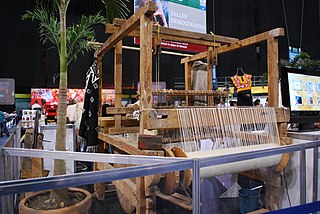
The Fondo Nacional para el Fomento de las Artesanías or National Fund for the Development of Arts and Crafts is a dependence of the Secretariat of Social Development (SEDESOL). It was established in 1974 to promote and protect traditional Mexican handcrafts. The agency has four main programs including artisan training, retail selling and the sponsoring of craft competitions as the local, regional and national level. FONART directly helped 26,600 artisans in 2006, but the agency has been criticized for being inefficient and not meeting the demands of national transparency laws. Currently, it seeks the capacity to authenticate crafts on a national and international level due to competitions from imitations from Asia.
According to the Mexican government agency Conapo, Oaxaca is the third most economically marginalized states in Mexico. The state has 3.3% of the population but produces only 1.5% of the GNP. The main reason for this is the lack of infrastructure and education, especially in the interior of the state outside of the capital. Eighty percent of the state's municipalities do not meet federal minimums for housing and education. Most development projects are planned for the capital and the surrounding area. Little has been planned for the very rural areas and the state lacks the resources to implement them. The largest sector of Oaxaca's economy is agriculture, mostly done communally in ejidos or similar arrangements. About 31% of the population is employed in agriculture, about 50% in commerce and services and 22% in industry. The commerce sector dominates the gross domestic product at 65.4%, followed by industry/mining at 18.9% and agriculture at 15.7%.

The Museo Estatal de Arte Popular de Oaxaca or MEAPO is a small museum in the municipality of San Bartolo Coyotepec just south of the city of Oaxaca in Mexico. It is run by the state of Oaxaca to showcase the entity's handcrafts and folk art tradition, through its permanent collection, online "cyber-museum", collaboration with national and international entities, and sponsorship of events such as craft markets, conferences, and temporary exhibitions. It is dedicated to the crafts and to the artisans and the cultures behind the items. Its collection contains samples of most of the crafts produced in the state, especially the Central Valleys region, but most of its collection consists of barro negro pottery, the specialty of San Bartolo Coyotepec. It is run by director Carlomagno Pedro Martínez, a recognized artisan and artist in barro negro.

Museo Universitario de Artes Populares María Teresa Pomar is a museum dedicated to Mexico's handcrafts and folk art tradition, called “artesanía.” It is part of the University of Colima in the city of Colima, founded by artesanía collector and promoter María Terea Pomar. It contains one of the most important collections of its type in Mexico, covering traditions from around the country as well as the artesanía and traditions of the state of Colima.

Carlomagno Pedro Martínez is a Mexican artist and artisan in “barro negro” ceramics from San Bartolo Coyotepec, in the Mexican state of Oaxaca. He comes from a family of potters in a town noted for the craft. He began molding figures as a child and received artistic training when he was 18. His work has been exhibited in Mexico, the U.S. and Europe and he has been recognized as an artist as well as an artisan. Today, he is also the director of the Museo Estatal de Arte Popular de Oaxaca (MEAPO) in his hometown. In 2014, Martínez was awarded Mexico's National Prize for Arts and Sciences

Doña Rosa, full name Rosa Real Mateo de Nieto, was a Mexican ceramics artisan from San Bartolo Coyotepec, Oaxaca, Mexico. She is noted for inventing a technique to make the local pottery type, barro negro, black and shiny after firing. This created new markets for the ceramics with collectors and tourists.
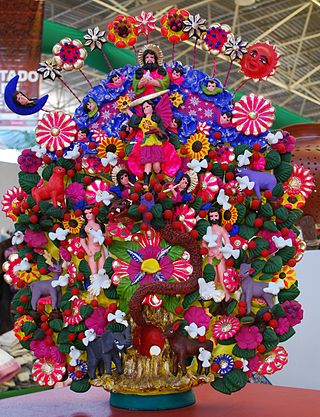
The pottery of Metepec is that of a municipality in central Mexico, located near Mexico City. It is noted for durable utilitarian items but more noted for its decorative and ritual items, especially sculptures called “trees of life,” decorative plaques in sun and moon shapes and mermaid like figures called Tlanchanas. Metepec potters such as the Soteno family have won national and international recognition for their work and the town hosts the annual Concurso Nacional de Alfarería y Cerámica.
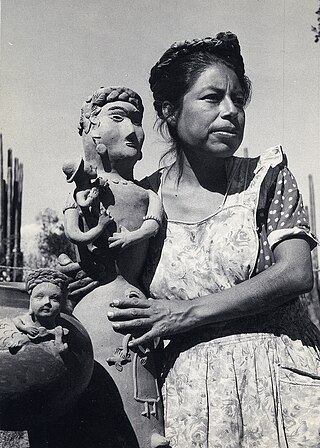
The Blanco family of Santa María Atzompa, Oaxaca, Mexico is noted for their ceramic production, especially decorative pieces. Their fame began with Teodora Blanco, who as a young child added decorative elements to the more utilitarian wares made by her parents. Eventually her work became noted by a foreigner who not only bought her entire production, also encouraged her to create new forms, leading to mostly human figures called “muñecas”. Her form of decoration, called “pastillaje,” was also an innovation for the area’s pottery and consists of small pieces of clay added onto the main surfaces, often covering much of the area. Teodora taught her children and although she intended that only the oldest daughter carry on her work, today three generations of the family continues making mostly decorative pottery, mostly following her work. These include Irma García Blanco, who have been recognized by the Fomento Cultural Banamex and Fernando Félix Pegüero García, who has won prizes from the Friends of Oaxacan Folk Art in New York and Premio Nacional de Cerámica in Tlaquepaque, Jalisco.

Alfonso Castillo Orta was a Mexican potter from the ceramics town of Izúcar de Matamoros, Puebla, whose work made the ceramics of this area internationally known. He was particularly known for his trees of life sculptures and received various awards for his work, including the Premio Nacional de Ciencias y Artes in 1996. He taught the craft to his wife and five children who continue to create pieces in his style in the family workshop.

Oaxaca handcrafts and folk art is one of Mexico's important regional traditions of its kind, distinguished by both its overall quality and variety. Producing goods for trade has been an important economic activity in the state, especially in the Central Valleys region since the pre-Hispanic era which the area laid on the trade route between central Mexico and Central America. In the colonial period, the Spanish introduced new raw materials, new techniques and products but the rise of industrially produced products lowered the demand for most handcrafts by the early 20th century. The introduction of highways in the middle part of the century brought tourism to the region and with it a new market for traditional handcrafts. Today, the state boasts the largest number of working artisans in Mexico, producing a wide range of products that continue to grow and evolve to meet changing tastes in the market.

Guanajuato handcrafts and folk art are mostly of European origin, although some indigenous work still survives in some communities. The most notable craft is the making of glazed mayolica pottery, followed by handmade traditional toys of various materials, especially a hard paper mache called cartonería. While handcrafts are not a large an industry here as in some other states, it does have several major handcraft markets which sell to tourists and foreign residents. Other handcraft traditions include wrought iron work, tin and glass, wood carving and leather working.

Tlaxcala handcrafts and folk art is that which comes from the smallest state in Mexico, located in the center-east of the country. Its best-known wares are the "canes of Apizaco", sawdust carpets and the making of Saltillo-style serapes. However, there are other handcraft traditions, such as the making of pottery, including Talavera type wares, cartoneria, metalworking and stone working. The state supports artisans through the activities of the Fideicomiso Fondo de la Casa de las Artesanía de Tlaxcala
Angélica Delfina Vásquez Cruz, also known as the Ceramista del Preciosismo, is a potter from Oaxaca, Mexico.




















